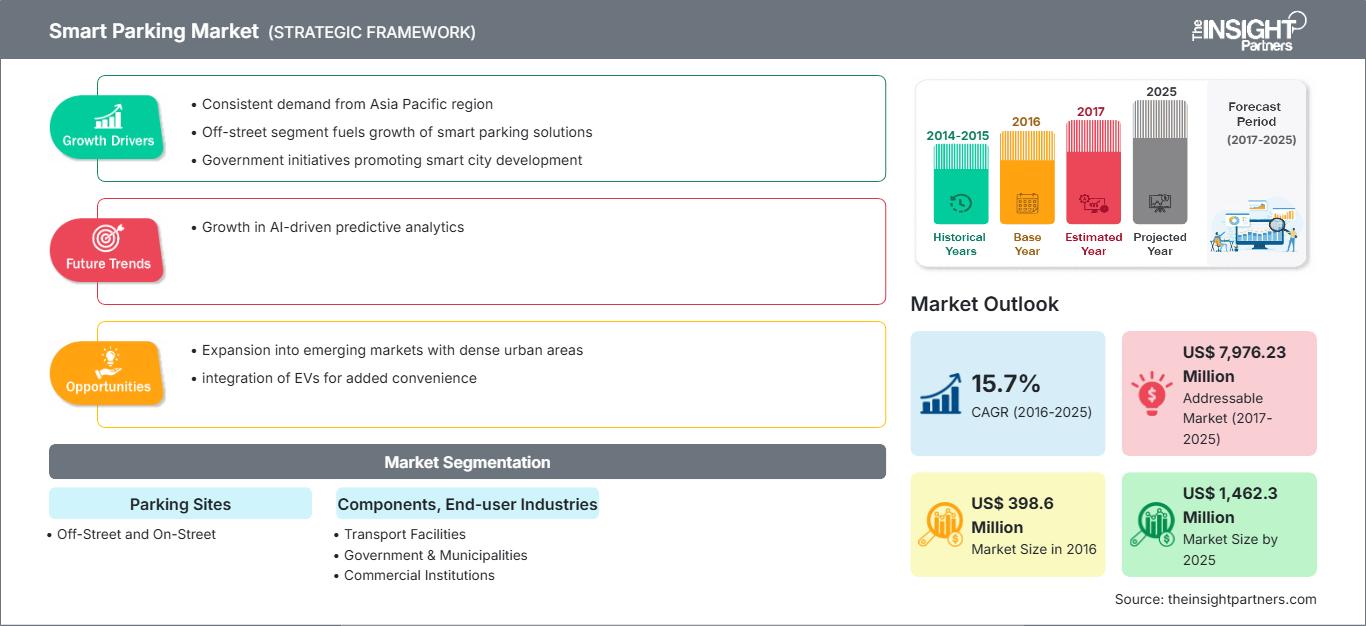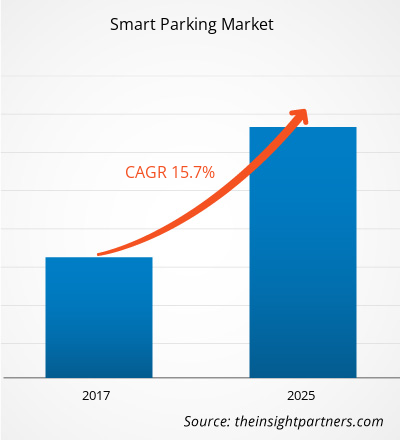Le marché du stationnement intelligent devrait passer de 398,6 millions de dollars américains en 2016 à 1 462,3 millions de dollars américains d'ici 2025, avec un TCAC de 15,7 % entre 2017 et 2025.
Les systèmes de stationnement intelligents répondent aux problèmes critiques de stationnement en permettant aux conducteurs de garer leur véhicule plus facilement, sans perte de temps ni de carburant. Ils fournissent à leurs utilisateurs des informations en temps réel sur les places de stationnement disponibles en ville, réduisant ainsi les embouteillages causés par une mauvaise gestion des places de stationnement. Amano Mcgann, Smart Parking Ltd., Xerox, Cisco et Urbiotica comptent parmi les principaux acteurs de ce marché. L'Amérique du Nord, région technologiquement avancée, avec un nombre élevé de véhicules et des embouteillages importants dans les villes, a connu la plus forte adoption de systèmes de stationnement intelligent par les gouvernements et les municipalités de diverses villes. L'Europe est le deuxième pays à adopter les systèmes de stationnement intelligents, tandis que la région Asie-Pacifique, avec son urbanisation croissante et ses tendances technologiques croissantes, devrait connaître la croissance la plus rapide au monde sur le marché du stationnement intelligent.
Aperçu du marché
Le marché du stationnement intelligent stimulé par la croissance continue de la demande en Asie-Pacifique
Actuellement, les systèmes de stationnement intelligents connaissent une adoption massive en Amérique du Nord et en Europe. De plus, grâce aux progrès technologiques et aux infrastructures, plusieurs économies en développement de la région Asie-Pacifique et Moyen-Orient et Afrique, notamment le grand projet de la ville de Wellington, et des projets pilotes à Canberra, Singapour, en Thaïlande, à Dubaï et en Arabie saoudite, devraient connaître une adoption massive de solutions de stationnement intelligent. Bien que l'Amérique du Nord et l'Europe dominent le marché mondial du stationnement intelligent, elles devraient perdre des parts de marché au profit de l'Asie-Pacifique au cours de la période de prévision. En revanche, la région Asie-Pacifique devrait enregistrer une croissance de 18,9 % sur la période 2016-2025.Personnalisez ce rapport en fonction de vos besoins
Vous bénéficierez d’une personnalisation sur n’importe quel rapport - gratuitement - y compris des parties de ce rapport, ou une analyse au niveau du pays, un pack de données Excel, ainsi que de profiter d’offres exceptionnelles et de réductions pour les start-ups et les universités
Marché du stationnement intelligent: Perspectives stratégiques

-
Obtenez les principales tendances clés du marché de ce rapport.Cet échantillon GRATUIT comprendra une analyse de données, allant des tendances du marché aux estimations et prévisions.
Le marché mondial du stationnement intelligent est propulsé par le segment du stationnement hors voirie
Les avancées technologiques, telles que l'utilisation d'applications mobiles pour les systèmes de guidage de stationnement, l'amélioration des solutions de billetterie et de paiement, et la croissance significative de l'adoption des systèmes de stationnement intelligent par les entreprises et les particuliers, devraient stimuler la demande pour le marché des systèmes de gestion du stationnement hors voirie. Ce type de stationnement est avantageux pour les usagers du stationnement de courte comme de longue durée. Cependant, le coût initial élevé de déploiement des systèmes de stationnement hors voirie devrait freiner la croissance du marché. Le segment du stationnement hors voirie domine actuellement le marché mondial du stationnement intelligent et devrait maintenir sa domination au cours de la période de prévision.
L'initiative commerciale est considérée comme la stratégie la plus adoptée sur le marché mondial du stationnement intelligent. Quelques-unes des stratégies récentes de certains acteurs du marché du stationnement intelligent sont énumérées ci-dessous.
- 2017 : Amano Mcgann a étendu son partenariat avec l'un de ses plus anciens concessionnaires, PSX, au Colorado.
- 2017 : Valeo et Cisco ont annoncé un accord de coopération pour développer des innovations stratégiques dans les services de mobilité intelligente.
- 2017 : Smart Parking a annoncé avoir remporté un nouveau contrat en Nouvelle-Zélande, choisi par Wilson Parking New Zealand comme fournisseur privilégié de technologies de capteurs et de recherche de places sur neuf nouveaux sites.
- 2017 : Smart Parking a lancé sa nouvelle passerelle IoT SmartSpot, dotée de fonctionnalités nouvelles et améliorées adaptées aux besoins des villes intelligentes.
Aperçu régional du marché du stationnement intelligent
Les tendances régionales et les facteurs influençant le marché du stationnement intelligent tout au long de la période de prévision ont été analysés en détail par les analystes de The Insight Partners. Cette section aborde également les segments et la géographie du marché du stationnement intelligent en Amérique du Nord, en Europe, en Asie-Pacifique, au Moyen-Orient et en Afrique, ainsi qu'en Amérique du Sud et en Amérique centrale.
Portée du rapport sur le marché du stationnement intelligent
| Attribut de rapport | Détails |
|---|---|
| Taille du marché en 2016 | US$ 398.6 Million |
| Taille du marché par 2025 | US$ 1,462.3 Million |
| TCAC mondial (2016 - 2025) | 15.7% |
| Données historiques | 2014-2015 |
| Période de prévision | 2017-2025 |
| Segments couverts |
By Emplacements de stationnement
|
| Régions et pays couverts |
Amérique du Nord
|
| Leaders du marché et profils d'entreprises clés |
|
Densité des acteurs du marché du stationnement intelligent : comprendre son impact sur la dynamique des entreprises
Le marché du stationnement intelligent connaît une croissance rapide, portée par une demande croissante des utilisateurs finaux, due à des facteurs tels que l'évolution des préférences des consommateurs, les avancées technologiques et une meilleure connaissance des avantages du produit. Face à cette demande croissante, les entreprises élargissent leur offre, innovent pour répondre aux besoins des consommateurs et capitalisent sur les nouvelles tendances, ce qui alimente la croissance du marché.

- Obtenez le Marché du stationnement intelligent Aperçu des principaux acteurs clés
- Analyse historique (2 ans), année de base, prévision (7 ans) avec TCAC
- Analyse PEST et SWOT
- Taille du marché Valeur / Volume - Mondial, Régional, Pays
- Industrie et paysage concurrentiel
- Ensemble de données Excel
Rapports récents
Témoignages
Raison d'acheter
- Prise de décision éclairée
- Compréhension de la dynamique du marché
- Analyse concurrentielle
- Connaissances clients
- Prévisions de marché
- Atténuation des risques
- Planification stratégique
- Justification des investissements
- Identification des marchés émergents
- Amélioration des stratégies marketing
- Amélioration de l'efficacité opérationnelle
- Alignement sur les tendances réglementaires






















 Obtenez un échantillon gratuit pour - Marché du stationnement intelligent
Obtenez un échantillon gratuit pour - Marché du stationnement intelligent